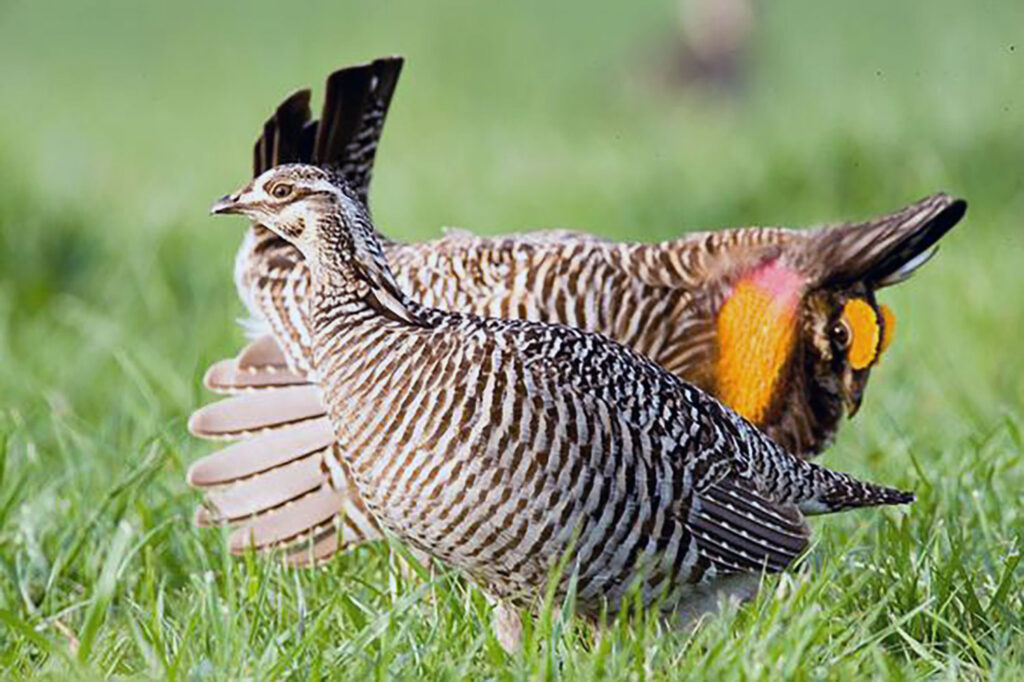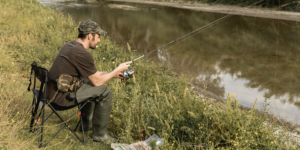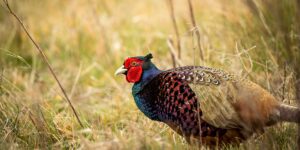The greater prairie chicken is an iconic Great Plains upland bird that hunters should pursue before it’s too late.
The greater prairie chicken is a prairie grouse species that has called the Great Plains of the central U.S. home for centuries. Not to be confused with lesser prairie chickens, which cannot be hunted because of low bird numbers, the greater prairie chicken is known for its unique mating dance, and its horn like feathers that protrude during the dance.
Why limit yourself to public land when there are millions of acres of private land to explore.
What is a Greater Prairie Chicken?
Greater prairie chickens are a species of grouse, but are unique to other grouse species, such as the sharp tailed grouse, because of their pinnae, or long neck feathers that flare upward like horns on males when they are showcasing courting displays. Males also have a unique yellow neck sack, and are large in size and feature a booming call rather than a gobble like their co-species, the lesser prairie chicken.
The greater prairie chicken is famous for its mating dance that is done on special ground called a lek, which is typically a flat, raised piece of ground with short grass. Males gather together on leks to perform the mating dance where they strut with their heads low and and pinnae feathers flared and yellow neck sacks puffed out, while their wings are held stiffly at their sides.
Prairie chickens are non-migratory birds and live in native prairies. They were once prominent across the midwest and central U.S., but populations have decreased over time due to habitat loss. The prairie chicken has not reached the Endangered Species List, but is listed as threatened in some states.
Best Habitat for Prairie Chicken Hunting
Prairie chicken habitat is primarily tallgrass prairie with croplands dispersed between. They can also be found in areas of oak woodland, which consists primarily of oak trees that are dispersed enough for native grasses to grow tall between. Like their name, prairie chickens prefer mixed grass prairies that may consist of switchgrass or bluestem. Greater prairie chickens avoid areas with large trees, telephone poles, or even wind turbines where predators can perch and be a threat.
For nesting, hens require dense brush to hide nests under, but will forage in the open prairies for insects and seeds. In late winter, greater prairie chickens can be found near croplands for a supplemental food source and will travel regularly between nesting sites and food sources.
Best States for Prairie Chicken Hunting
The greater prairie chicken is dispersed across different states, but are primarily found in Kansas and Nebraska. Northeast Oklahoma also hosts prairie chickens, as well as South and North Dakota. Small populations can be found in Minnesota, Wisconsin and Iowa. Not all of these states allow hunting of the species because of small populations, and many states have short seasons for prairie chickens because of their low and dwindling numbers.
Kansas and Nebraska are the two most popular states for hunters to chase the prairie grouse.
The Flint Hills of Kansas is home to the largest population of greater prairie chicken, while the Nebraska Sandhills feature the widespread tallgrass and croplands that the birds call home. Hunters can also hunt prairie chickens in Colorado, Minnesota, and South Dakota, but in specific areas only.
Prairie Chicken Hunting Regulations and Restrictions
The greater prairie chicken has suffered population decline for many years because of their primary grassland habitat being converted to croplands and human encroachment. Where prairie chicken numbers were once prominent, they now have extirpated (become locally extinct) and are listed as endangered in some states such as Iowa.
Hunting prairie grouse is still legal in some states where populations are stable, but bag limits are generally small, ranging from two to three birds a day—with some states only allowing two a season. Some states only allow hunting in a greater prairie chicken unit, and some units have different seasons from each other. Some states even require hunters to have a permit to hunt prairie chickens.
This prairie grouse is carefully managed, so hunting seasons and bag limits differ from state to state. It’s important for prairie chicken hunters to carefully check regulations before heading afield.

Prairie Chicken Hunting Techniques
Hunting greater prairie chickens is a little different than typical upland hunting. In the early season, hunting is best done by hiking prairies with a bird dog who can range and hold birds on point. Young prairie chicken tend to hold well, and are good for young bird dogs learning the ropes, as well as good for hunters who can get close before the birds flush. Adult birds are known to be very wary of danger and will often flush out of gun range, making hunters cover a lot of ground for close opportunities at birds.
Late in the season, hunters have the best chance at bagging a prairie chicken by setting up on field edges like a duck or dove hunter and pass shooting the birds rather than hiking. Prairie chickens feed on cut grain fields later in the season, and will move from their nesting and roosting areas to feed early in the morning. Hunters can find success by setting up shop on the edge of grain fields and catch birds as they fly by to feed. Conceal yourself well by bales of hay, or even in a portable blind. Wear camouflage and stand still so as not to alert birds to your presence. Scout ahead of time by watching fields or talking to local farmers to determine exact bird movement for better odds at intercepting prairie chickens as they fly to feed.
Don’t be deceived. Prairie chickens may appear to be flying slowly, but they are fast flying upland birds and pass shooting them takes practice. Hit the range and practice shooting hard crossing shots on clay birds. This will help you get in front of the birds and bring a prairie chicken to bag.
The hassle free way to monetize your acreage.
Prairie Chicken Hunting Equipment
In the early season, when birds may hold better and be in close shooting range, a 20-gauge shotgun works well for the hiking hunter who has to hike through thick prairie grass for a chance at a prairie chicken. When pass shooting a prairie chicken, a 12-gauge may be a better option since birds are at longer distances flying between nesting and feeding grounds.
Hunters should feed their guns with #6 or #7.5 shot to bring down the medium sized bird. Opt for a modified and improved cylinder choke to extend the range on your shot since prairie chickens tend to flush at the edge of shotgun range.
A lightweight pair of hunting boots that are well broken in should be in every upland hunters gear kit, including prairie chicken hunters who trek across the prairie lands in search of birds in the early season. For late season hunting, invest in camouflage or neutral colors to blend into your surroundings when still hunting prairie chickens. A portable blind may be beneficial for field edges while pass shooting birds, as well.he map pins below to learn more about the properties.A lightweight pair of hunting boots that are well broken in should be in every upland hunters gear kit, including prairie chicken hunters who trek across the prairie lands in search of birds in the early season. For late season hunting, invest in camouflage or neutral colors to blend into your surroundings when still hunting prairie chickens. A portable blind may be beneficial for field edges while pass shooting birds, as well.
Click on one of the map pins below to learn more about the properties.
Where to go Prairie Chicken Hunting: Public vs Private Land
Tallgrass prairie is where hunters will find greater prairie chicken populations. These grasslands are most prominent in the central part of the U.S. in the Great Plains states. Loss of habitat has been an issue for decades for the greater prairie chicken, however the federal conservation reserve program (CRP) and other conservation easement programs have helped populations of the wild birds, as well as large swaths of National Grasslands.
Public Land
Thousands of acres of public lands are open to prairie grouse hunting. The most dense populations of prairie chickens are found in Kansas, particularly the Flint Hills which extends from the Oklahoma border northward towards Nebraska. North central Kansas also boasts large numbers of birds, while prairie chicken numbers have increased in western Kansas thanks to lands enrolled in the federal conservation reserve program.
As with all public land hunting, they are open to all sportsmen and women to hunt freely during the hunting season. Birds may be more pressured because of high traction, so public land hunters should be prepared for birds to flush at the edge or out of shotgun range. But the thousands of acres of public land and private lands enrolled in the CRP program and walk in hunting areas give hunters plenty of free opportunities to hunt prairie chickens.
Private Land
Ranchers across the Great Plains that have protected some grasslands on their land are privy to high numbers of prairie grouse because they house both feed and cover that the birds need to survive. These private lands are ideal hunting lands, especially for those who can gain permission. Birds will be less pressured on private land, and landowners may be able to give you insight into exactly where the birds are located.
Private land access can be granted by asking for permission, or through programs such as Wing It that partners with private landowners to enroll their lands to open access to hunters for a small fee. This gives hunters an opportunity to hunt prairie chickens on private land that only they have access to for the day—giving them ample opportunity to bring a greater prairie chicken to bag.
Why limit yourself to public land when there are millions of acres of private land to explore.



